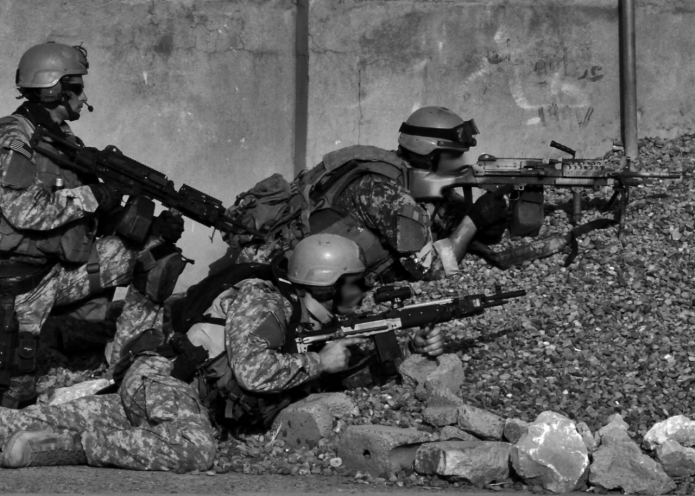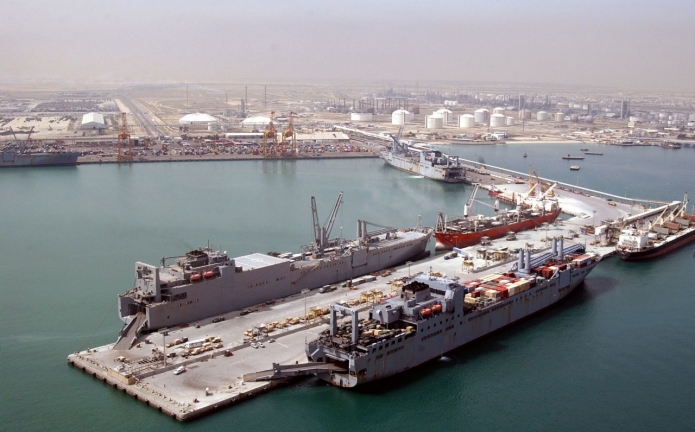Operation Iraqi Freedom

Medal of Honor recipient Special Warfare Officer Second Class (SEAL) Michael A. Monsoor (kneeling) with his squad while deployed to Iraq in 2006.
On 20 March 2003, Operation Iraqi Freedom (OIF) began with preemptive airstrikes on former Iraqi dicator Saddam Hussein’s presidential palace and selected military targets. The initial assault was followed by approximately 67,700 “boots on the ground” with 15,000 Navy personnel on ships in the region. OIF was authorized when Iraq was found to be in breach of UN Security Council adopted Resolution 1441, which “prohibits stockpiling and importing weapons of mass destruction (WMDs).”
Iraqi forces were overwhelmed quickly and Baghdad fell a mere five weeks after the invasion began. With the invasion complete, an insurgency and influx of al Qaeda inspired fighters poured into the country that sparked guerilla warfare tactics against U.S. troops and civil war between the Sunni and Shia tribes. On 15 December 2011, “The Chairman of the Joint Chiefs of Staff and other top U.S. military leaders observed the official end of U.S. Forces Iraq’s mission after nearly nine years of conflict that claimed the lives of nearly 4,500 troops (Torreon).”
After U.S. forces withdrew from Iraq, the Islamic State of Iraq and Syria (ISIS) invaded areas of Syria and Iraq, causing widespread causalities, destruction of the country’s infrastructure, and barbaric practices against citizens. In response to the terrorists group, Operation Inherent Resolve began on 17 October 2014.
Reference
Torreon, Barbara. 2016. “U.S. Periods of War and Dates of Recent Conflicts.” Congressional Research Report for Congress (September 29): 8–9.
*****
Suggested Reading
- Irregular Enemies and the Essence of Strategy
- Bibliography of Irregular Warfare
- Naval Special Warfare
- Terrorism: A Navy Department Library Research Guide
- U.S. Occupation Assistance: Iraq, Germany and Japan Compared
- Memorial Honoring Floridians Lost in Iraq and Afghanistan on Display at National Naval Aviation Museum
- A Guide to U.S. Military Casualty Statistics
- Cost of Major U.S. Wars
- Peacekeeping and Related Stability Operations: Issues of U.S. Military Involvement
- Unmanned Vehicles for U.S. Naval Forces: Background and Issues for Congress
- Writing U.S. Naval Operational History 1980-2010: U.S. Navy Mine Countermeasures in Terror and War
- Peacekeeping and Related Stability Operations: Issues of U.S. Military Involvement
- U.S. Democracy Promotion Policy in the Middle East
- Perspectives of Enhanced Interrogation Techniques
- Naval Support Activity Bahrain
Notable People
Artifact
Navy Art

The U.S. Navy’s Military Sealift Command ships unloaded cargo in support of Operation Iraqi Freedom in the port of Ash Shuaybah, Kuwait. The sealift program provided high-quality, efficient, and cost-effective ocean transportation for the Department of Defense and other U.S. federal agencies. More than 90 percent of U.S. warfighters’ equipment and supplies travels by sea. (photo courtesy of Military Sealift Command).


